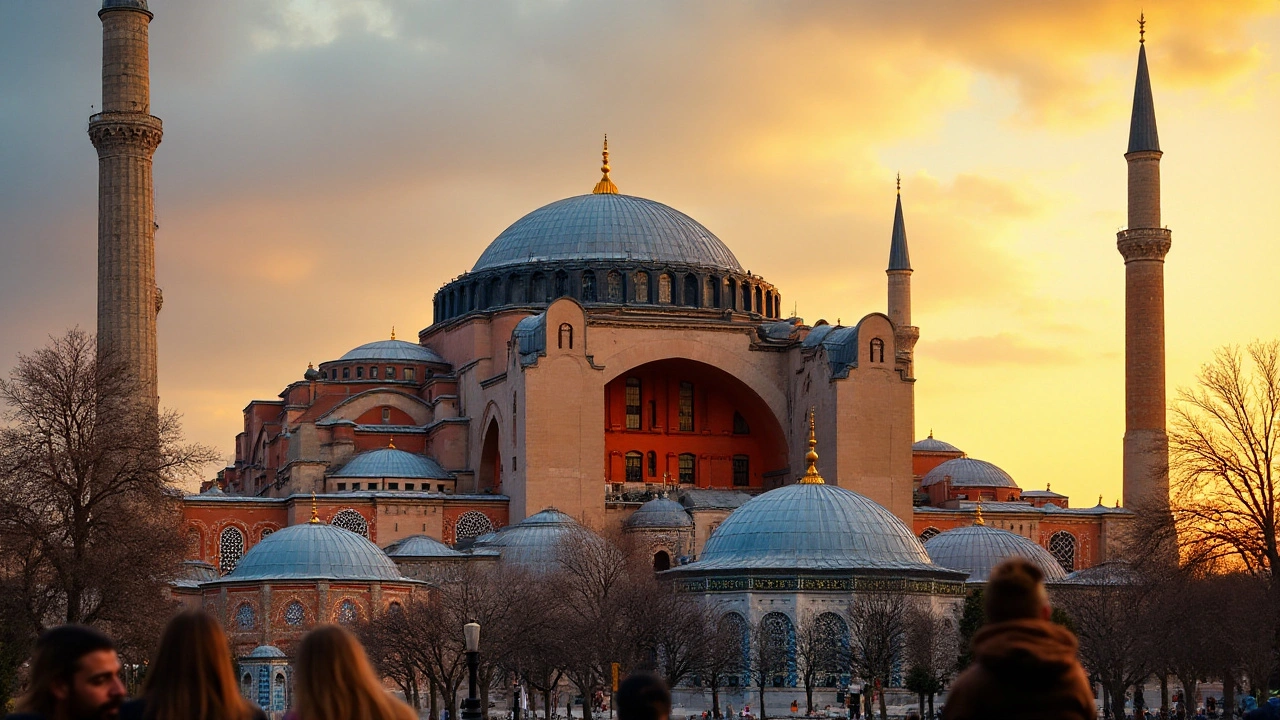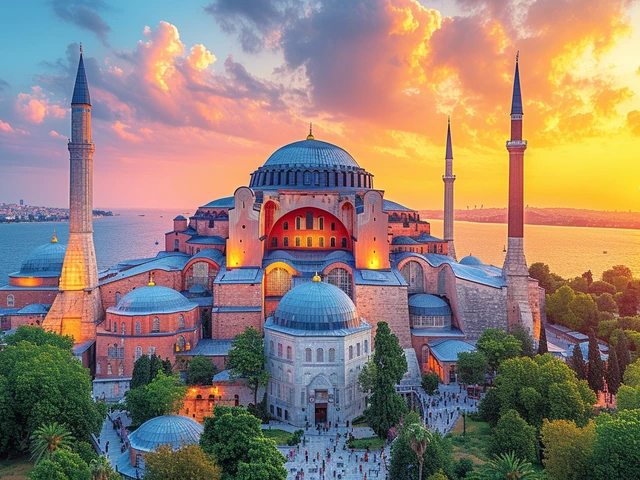Byzantine architecture represents an intriguing blend of Eastern and Western styles. Initially widespread during the Byzantine Empire, it draws from Roman and Persian influences to create something wholly unique.
The origins of Byzantine architecture can be traced back to the early 4th century. This style developed when Emperor Constantine moved the capital of the Roman Empire to Byzantium, later renamed Constantinople.
Key features include domes, mosaics, and the extensive use of marble. The Hagia Sophia in Istanbul, a prime example, epitomizes these elements with its majestic dome and intricate mosaics. This iconic structure, initially a cathedral, later served as a mosque and now functions as a museum.
Byzantine architecture left an indelible mark on subsequent architectural styles, influencing both Islamic and European medieval architecture. Structures like the Hagia Sophia not only represent artistic achievement but also symbolize the harmonious blend of diverse cultural elements.
- Origins and Development
- Key Features of Byzantine Architecture
- Notable Examples and Landmarks
- Influence and Legacy
Origins and Development
The story of Byzantine architecture begins with a significant historical shift. In 324 AD, Emperor Constantine decided to move the capital of the Roman Empire from Rome to Byzantium, which he later renamed Constantinople (modern-day Istanbul). This strategic decision was backed by the city's advantageous geographical position, serving as a bridge between Europe and Asia. This move catalyzed the fusion of Eastern and Western architectural styles, laying the foundation for what we now recognize as Byzantine architecture.
The early phase of Byzantine architecture, often referred to as the 'First Golden Age,' saw the incorporation of Roman elements such as the basilica form, grand arches, and intricate mosaics. Yet, it wasn't just a mere replication of Roman techniques. As Constantinople grew in importance, so did the need for structures that could symbolize its newfound prestige. The result was a unique style characterized by the adoption of domes supported by pendentives, which allowed for the construction of expansive, open interiors.
One of the most iconic structures from this period is the Hagia Sophia. Originally commissioned by Emperor Justinian I in 532 AD, the Hagia Sophia epitomizes the daring engineering and artistic ambition of the Byzantine Empire. The building's massive dome, which appeared to float above the nave, became a hallmark of Byzantine design. Its walls were adorned with shimmering mosaics that depicted sacred figures and scenes, making it a visual masterpiece of its time.
“Architecture should speak of its time and place but yearn for timelessness.” – Frank Gehry
As the empire expanded, so did the reach of its architectural style. By the 6th century, Byzantine architects began to influence regions far beyond Constantinople. They brought their unique blend to places like Ravenna in Italy, where the Basilica of San Vitale stands as a testament to the style's grandeur. The building's octagonal layout and lush mosaics are clear indicators of Byzantine influence.
This period also marked the evolution of church design. Earlier Christian basilicas featured simple, rectangular layouts, but Byzantine architects opted for more complex and centralized plans. They excelled in creating spaces that felt both majestic and intimate, an achievement realized through the clever use of light and fully adorned interiors. This was not limited to religious buildings; civic structures also adopted these elaborate designs, as seen in the Grand Palace of Constantinople.
By the 9th century, during what is often termed the 'Second Golden Age,' Byzantine architecture had fully matured. The use of brick became more prevalent, and architects began to incorporate more elaborate decorative patterns into their work. Monumental churches like the Nea Ekklesia, built during the reign of Basil I, featured facades adorned with marble plaques and intricate carvings. This era saw the proliferation of smaller, cross-in-square structures that could be easily replicated across the empire's vast territories.
In sum, the origins and development of Byzantine architecture represent a dynamic fusion of cultural influences and technological innovations. This architectural style not only reflected the empire's grandeur but also facilitated the blending of artistic traditions from East and West, making it a remarkably resilient and influential form of expression.
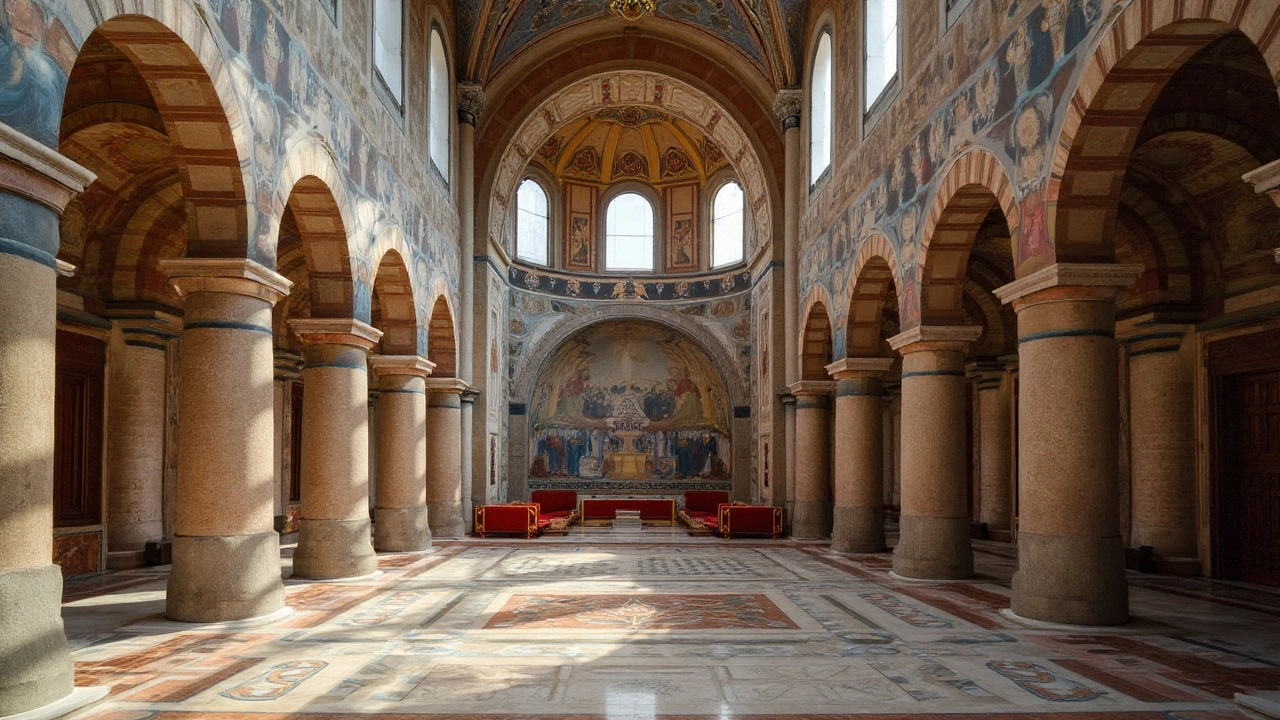
Key Features of Byzantine Architecture
Byzantine architecture stands out for its unique blend of artistic and structural elements derived from both Eastern and Western traditions. One of the most notable features is the use of the dome, which is often placed over a square base using pendentives or squinches to support the circular structure. This innovative design creates an awe-inspiring sense of vertical space, epitomized by landmark structures like the Hagia Sophia.
Apart from the architectural ingenuity, the interior of Byzantine buildings is just as remarkable. Lavish use of mosaics made up of tiny pieces of colored glass, stones, or tiles, adorn the walls and ceilings. These intricate mosaics generally depict religious scenes and figures, making the interiors visually stimulating and spiritually uplifting. The use of iconography also plays a significant role, serving not only as decoration but as symbolism deeply embedded in the Orthodox Christian faith.
"The harmony and balance of form achieved by Byzantine architects transcended mere construction; it was a spiritual endeavor," noted architecture scholar Robert Ousterhout.
The Byzantine style is characterized by the extensive use of marble for floors and columns. Elaborate carvings and inlays, often employing semi-precious stones, are typical in these large expanses of marble, making for a grand and opulent visual effect. Columns frequently feature intricate capitals, often adorned with floral or animal motifs, which add to the overall aesthetic richness.
Another characteristic feature is the plan of the buildings. Many Byzantine churches follow a central plan, often shaped like a Greek cross with arms of equal length. This contrasts sharply with the longitudinal layout of Western basilicas, highlighting the architectural divergence and fusion inherent to the style. Occasionally, you will also find buildings with an octagonal or circular plan, reflecting the diversity within the tradition.
The variety in window design in Byzantine architecture is also quite notable. Large, arched windows often fill the buildings with natural light, fostering a sense of openness and divine presence. These windows frequently incorporate decorative elements like stained glass or intricate tracery, adding to their aesthetic appeal. The emphasis on light is not merely functional but is often imbued with theological symbolism, representing the divine light of God.
Byzantine architects also paid meticulous attention to acoustics. The reverberative quality within these buildings often enhances liturgical chanting, making the sound resonate through the domed interiors. This acoustic consideration is subtle yet profound, augmenting the spiritual experience of those inside.
Materials like brick and stone are commonly used in construction, often arranged in alternating layers for a distinctive striped appearance. This technique, combined with the use of arches and vaults, provides structural robustness, allowing these edifices to survive centuries of wear and tear.
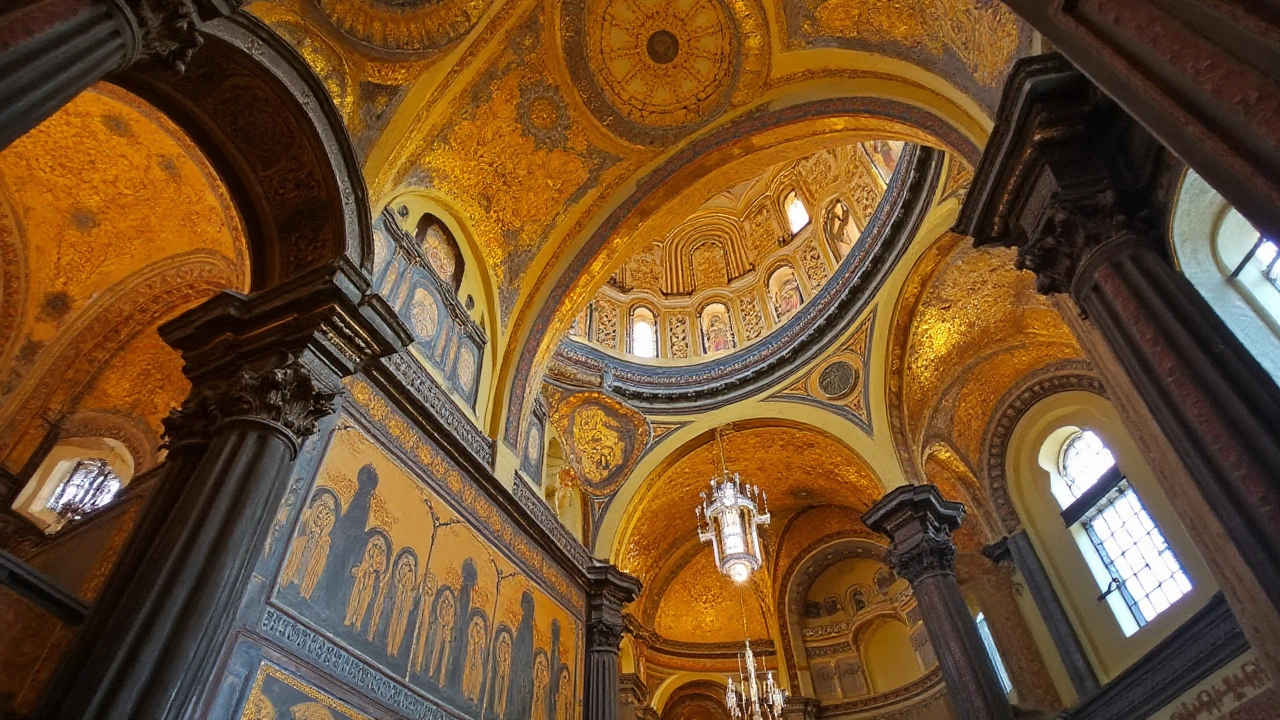
Notable Examples and Landmarks
Byzantine architecture boasts several influential and awe-inspiring landmarks that stand as testaments to its unique blend of styles. One of the most famous examples is the Hagia Sophia in Istanbul. Initially constructed as a cathedral under Emperor Justinian I in 537 AD, this monumental structure became a mosque and is now a museum. Its enormous dome, which appears to float above the central nave, is a marvel of engineering and design. The mosaics within, depicting religious figures, glitter in the light, adding to the ethereal sense of holiness and grandeur. The Hagia Sophia is often considered the epitome of Byzantine architecture, blending Roman engineering with Greek aesthetics and Persian artistic influences.
Another significant example is the Basilica of San Vitale in Ravenna, Italy. Completed in 547 AD, this church is famed for its stunning mosaics, particularly those depicting Emperor Justinian and his wife, Theodora. The church’s central octagonal plan and the use of space and light were revolutionary at the time. The mosaics, rich with gold and vibrant colors, illustrate biblical scenes and convey a sense of divine presence. According to the Italian historian Paola Raffaella David, “The mosaics of San Vitale are a visual narrative that connects the human and the divine.”
Moving to Greece, the Hosios Loukas Monastery offers another stunning example of Byzantine design. Located near the town of Distomo, this UNESCO World Heritage site is renowned for its intricate mosaics and marble work. Built in the 10th century, Hosios Loukas combines the elements of cross-in-square plan with an emphasis on verticality and spacious interior. The artwork within, mainly featuring religious iconography, serves as an exemplary illustration of Middle Byzantine artistry and theology.
Don’t miss out on the Nea Moni on the island of Chios. This monastery, dating back to the mid-11th century, is another UNESCO World Heritage site. It’s famous not just for its architecture but also for its mosaics, which are regarded as some of the finest examples of Byzantine art. The complex includes a main church, mausoleum, and cistern, each showcasing the characteristic domes, arches, and detailed mosaics common in Byzantine design. The use of light within the church, streaming through windows to illuminate the gold tesserae, creates an almost heavenly effect.
Lastly, it’s essential to discuss the influence of Byzantine architecture in other regions. The Cathedral of Saint Mark in Venice is a grand example. While not purely Byzantine, this cathedral owes much of its design to Byzantine influences, visible in its domes, mosaics, and overall layout. The cathedral was constructed in the 11th century and has been dubbed the ‘Chiesa d’Oro’ or ‘Church of Gold’ due to its opulence. The blend of various styles in this cathedral serves as a lasting legacy of Byzantine architectural principles.
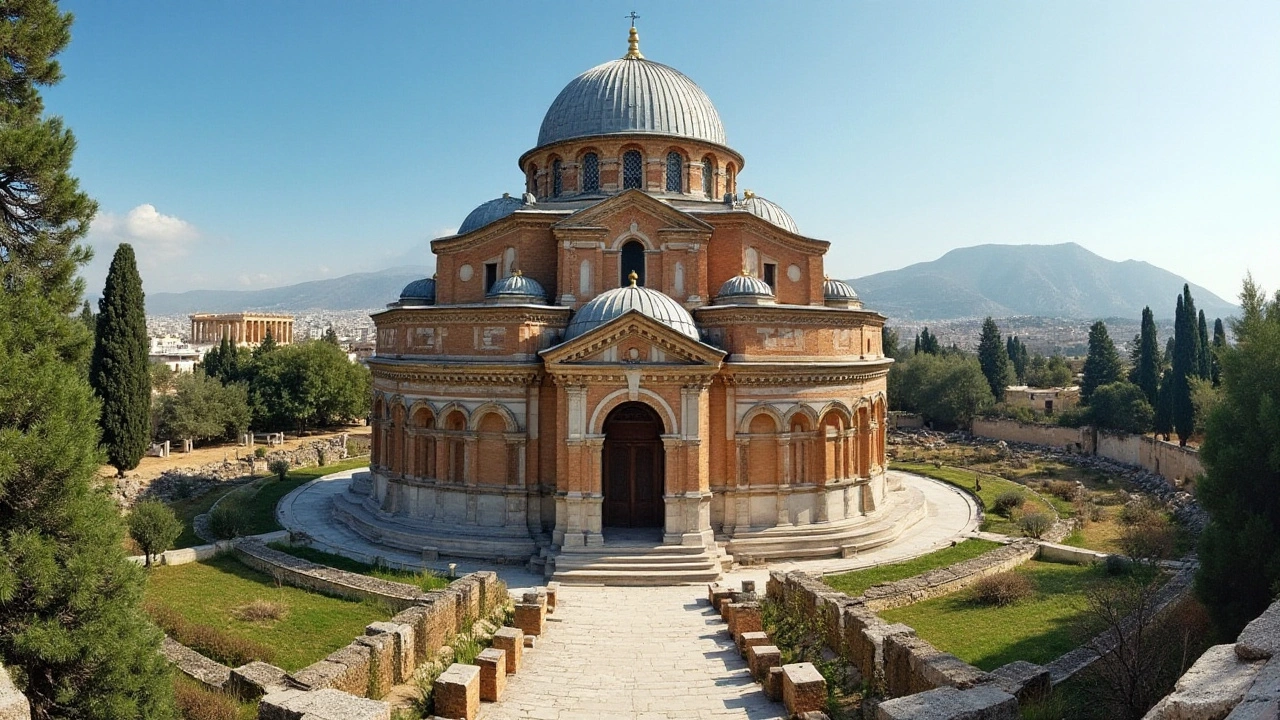
Influence and Legacy
The influence of Byzantine architecture is vast, stretching far beyond the boundaries of the Byzantine Empire itself. This style not only transformed the architectural landscape of the Eastern Roman Empire but also left a lasting imprint on both Islamic and medieval European architecture. The intricate fusion of elements such as domes, arches, and mosaics became a blueprint for future generations.
One of the most significant contributions of Byzantine architecture is the iconic dome, exemplified by structures like the Hagia Sophia. The use of the dome influenced many mosques throughout the Islamic world. For instance, the design of the Dome of the Rock in Jerusalem and the Umayyad Mosque in Damascus shows clear Byzantine influences. The structural and aesthetic features of these buildings carried the signature elements of Byzantine design, notably the hemispherical dome and the extensive use of opulent mosaics.
An interesting fact is that the great domed churches of the Byzantine Empire also impacted the Russian Orthodox Church. The famous onion domes of St. Basil's Cathedral in Moscow bear a striking resemblance to Byzantine architectural styles. The blending of these elements demonstrates the extensive reach of Byzantine aesthetic principles across different cultures and eras.
Moreover, during the middle ages, Western Europe saw the rise of the Romanesque architectural style, heavily borrowing from Byzantine designs. The use of thick walls, sturdy piers, and large towers in Romanesque churches can trace their roots back to Byzantine engineering innovations. The cross-in-square plans and elaborate decorative mosaics also made their way into many Western European structures.
The British art historian Sir Banister Fletcher noted, 'The Byzantines set the architectural tenor of centuries to come.'
Looking at specific examples, the Basilica of San Vitale in Ravenna, Italy, is a testament to the diffusion of Byzantine design. Although located in Italy, this church embodies the quintessential features of Byzantine architecture, from the octagonal plan to the stunning mosaics depicting Emperor Justinian and Empress Theodora. This blending of East and West elements showcases how Byzantine architecture served as a bridge, influencing multiple architectural traditions.
Modern architecture also nods to Byzantine principles. Contemporary architects occasionally employ Byzantine elements like expansive domes and detailed interior decorations in their works. This resurgence in Byzantine styles is especially noticeable in regions seeking to celebrate their historical and cultural ties to the Byzantine Empire, creating a seamless fusion of past and present architectural traditions.

